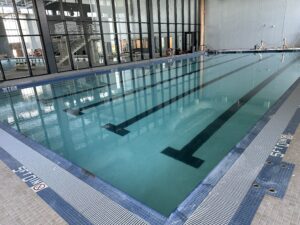Dive into Learning: Aquatic Experiences for 2nd and 3rd Grade Students
There’s something new in our elementary curriculum this year — swimming! The Aquatic Experiences program will take place at the new, state-of-the-art Waukee Community School District (CSD) Natatorium.
What is the Aquatic Experiences Program?
“Each 2nd and 3rd grade class in the District will take a five-day course at the Waukee CSD Natatorium. The best age to teach students to swim is when they are younger. We decided to start Aquatic Experiences with 2nd and 3rd-grade students because most students in this age range can change into their swimsuits, attend the class, and change back by themselves,” says Bobby Kelley, Waukee CSD Director of Aquatics.
The five-day Aquatic Experiences program is part of the elementary curriculum — it doesn’t replace PE or any other class.
“Our primary goal is to teach students a foundation of knowledge to be safe around water. Second, they learn to swim and can leisurely enjoy it. These classes will open the eyes of students that swimming is fun,” Kelley says.
What Will Students Experience During an Aquatics Lesson?
Students will take a bus from their school to the Natatorium. Once inside, the students will grab a District-provided towel and head to the locker rooms to put on the swimsuit they’ve brought from home. If a student doesn’t have a swimsuit (or forgot it) the District will provide clean suits for students to borrow and return.
Each locker room has stalls for the students to use for privacy. There are also individual changing rooms if that makes a student more comfortable. Students will then head to the program pool, which is a smaller pool (3-5 feet deep) that will be closed off from the larger competition pool at the facility.
“Each 35-minute class starts on the deck of the program pool with a five to ten-minute discussion about water safety. Students will learn about never swimming without an adult present, never diving into shallow or murky water, and even that it’s not safe to walk on ice at a pond. I usually lead that part of the course because I am very passionate about water safety,” Kelley says.
After the safety discussion, students can get in the water for swimming lessons. The program will use the SwimAmerica curriculum, which lets students learn at their own pace.
“It doesn’t matter if you’re a beginner or more advanced — there’s something for everyone” Kelley explains.
Swim Lesson Stations
During the first lesson, students will be evaluated based on their skills. The stations are:
- Relaxed bubbles
- Floats and glides
- Front and back kicks
- Freestyle for a short distance without breathing
- Freestyle with breath
- Backstroke
- Breaststroke
- Butterfly
- Individual medley
After the students are assigned a number associated with a station, swim instructors will divide students into groups and teach swimming skills. Students are constantly being evaluated during their time in the pool. When a swim instructor recognizes that a student has mastered the skills at their current station, they’ll advance the student to the next station.
“Each time a student advances, they can choose to get out of the pool and ring a special bell to celebrate their accomplishment,” Kelley says.
What Happens if a Family Doesn’t Want Their Student to Swim?
That’s OK! If families don’t want their student to get into the water, they can work with their child’s teacher and school officials. Students will still learn valuable lessons on safety during their time at the Natatorium even if they aren’t getting in the water.
“We understand that it’s frightening when your child goes to a pool. The initial class can cause a lot of anxiety as you wonder how the class will work and if your child can handle changing into their suits,” Kelley says.
Rest assured that our students are safe at the Natatorium. They will be with a swim instructor, and a lifeguard will be on duty during classes. The student’s classroom teacher will also be present. The lower stations will stay close to the steps where the students can touch until they feel comfortable in the water.
Will the Program Expand to More Grade Levels?
While Kelley says the Aquatic Experiences program may expand, it’s important to begin by focusing on teaching younger students to swim.
“If they haven’t learned to swim by age 9, they start taking on the characteristics of an adult who doesn’t know how to swim. It’s much harder to gain their trust, get them to relax, and teach them to float. It’s much easier with children ages 5 to 8,” Kelley says.
While not all grades will participate in Aquatic Experiences during the school day, swim lessons will be offered at the Natatorium beginning in the spring and summer of 2025. Priority access and a discounted rate will be given to Waukee CSD students. If any slots remain, the lessons will then be open to students from other districts and schools.
“If 2nd and 3rd graders return for swimming lessons after completing the Aquatic Experience, we’ll have their station number in our database. They will begin where they left off each time they participate in lessons with us,” Kelley says.
What’s Needed to Be a Swim Instructor?
Our program isn’t successful without the swim instructors teaching our children. We are looking for instructors who can work at the Natatorium from 9:15 a.m. to 1:30 p.m. You will earn all the certifications you need once employed at the Natatorium.
“If you are willing to work with children and get in the pool — we can go from there!” Kelley says.
Apply to Be a Swim InstructorIf you have additional questions about open jobs or Aquatic Experiences, please email Director of Aquatics Bobby Kelley at rkelley@waukeeschools.org.


